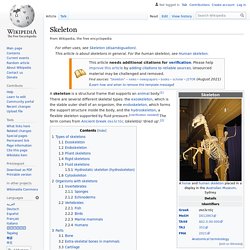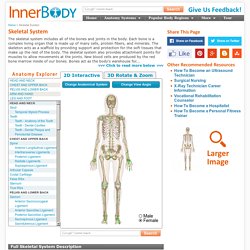

Skeleton - Wikipedia. Vein skeleton of a leaf.

Veins contain lignin that make them harder to degrade for microorganisms. The leaf came from Magnolia doltsopa(Magnoliaceae). The skeleton (from Greek σκελετός, skeletós "dried up"[1]) is the body part that forms the supporting structure of an organism. There are several different skeletal types: the exoskeleton, which is the stable outer shell of an organism, the endoskeleton, which forms the support structure inside the body, the hydroskeleton, and the cytoskeleton. Types of skeletons[edit] There are two major types of skeletons: solid and fluid. Exoskeleton[edit] Exoskeletons are external, and are found in many invertebrates; they enclose and protect the soft tissues and organs of the body.
The exoskeleton of insects is not only a form of protection, but also serves as a surface for muscle attachment, as a watertight protection against drying, and as a sense organ to interact with the environment. Endoskeleton[edit] Pliant skeletons[edit] Rigid skeletons[edit] Cell Types in Bones. Skeletal System Flashcards. Definition of skeletal system by Medical dictionary. Skeletal [skel´ĕ-tal] pertaining to the skeleton. skeletal systemthebody'sframework of bones;thereare206distinctbones in thebody of an averageadulthuman.

(SeeanatomicTable of Bones in theAppendicesandseePlates.)Thebonesgivesupportandshape to thebody,protectdelicateinternalorgans,andprovidesites of attachmentformuscles to makemotionpossible. In addition,theystoreandhelpmaintainthecorrectlevel of calcium, andthebone marrowmanufacturesbloodcells.Calledalsoskeleton. Main Parts of the Skeleton. Axial Skeleton.Theaxialskeletonincludestheskull,thespine,andtheribsandsternum.Themostimportant of these is thespine(calledalsothespinal or vertebral column), consisting of 26 separatebones.Twenty-fourvertebraehaveholesthroughthem,whicharelined up vertically to form a hollowtubecalledthespinal canal; thespinalcordrunsthroughthiscanaland is protected by it. Below the cervical vertebrae are 12 thoracic vertebrae; attached to them are 12 pairs of ribs, one pair to a vertebra.
Joints and Movement. System. Skeletal System – Labeled Diagrams of the Human Skeleton. [Continued from above] . . . calcium, iron, and energy in the form of fat.

Finally, the skeleton grows throughout childhood and provides a framework for the rest of the body to grow along with it. The skeletal system in an adult body is made up of 206 individual bones. These bones are arranged into two major divisions: the axial skeleton and the appendicular skeleton. The axial skeleton runs along the body’s midline axis and is made up of 80 bones in the following regions: SkullHyoidAuditory ossiclesRibsSternumVertebral column The appendicular skeleton is made up of 126 bones in the folowing regions: Upper limbsLower limbsPelvic girdlePectoral (shoulder) girdle SkullThe skull is composed of 22 bones that are fused together except for the mandible.
The bones of the superior portion of the skull are known as the cranium and protect the brain from damage. Hyoid and Auditory OssiclesThe hyoid is a small, U-shaped bone found just inferior to the mandible. Long. Human skeleton - Wikipedia. "Bone structure" and "skeletal system" redirect here.

For skeletal systems of other animals, see Skeleton. For for the scientific study of bones, see Osteology. The human skeleton is the internal framework of the body. It is composed of around 300 bones at birth – this total decreases to 206 bones by adulthood after some bones have fused together.[1] The bone mass in the skeleton reaches maximum density around age 20. The human skeleton can be divided into the axial skeleton and the appendicular skeleton. The human skeleton performs six major functions; support, movement, protection, production of blood cells, storage of minerals, and endocrine regulation.
Divisions[edit] Axial skeleton[edit] The upright posture of humans is maintained by the axial skeleton, which transmits the weight from the head, the trunk, and the upper extremities down to the lower extremities at the hip joints. Appendicular skeleton[edit] Functions[edit] Support[edit] Movement[edit] Protection[edit] Storage[edit]